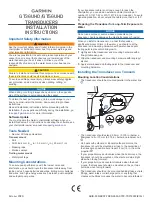
Basic Operating Instructions
17
Transmitting and Receiving
Notes
•
When transmitting, the RF output of the radio must be connected to an
antenna installed as explained in the Installation
section – page 104 (for
maintenance, you may also connect to a dummy load of suitable power
rating). Do not attempt to transmit when the antenna is not connected, or
when the antenna or any cable leading to it is physically damaged.
•
If the antenna system is equipped with an automatic antenna tuner and the
tuner is enabled, the radio will automatically tune the antenna tuner. In the
Channel mode, pressing the
ENTER
key automatically retunes the antenna.
➤
To transmit a voice message:
Press and hold down the Push-to-Talk (PTT) button on the side of the microphone or handset,
and speak slowly and clearly after the channel is clear. The TX LED turns on and remains lit
until the PTT button is released to indicate that you are “on-the-air”. You should hear a
sidetone, which verifies that your radio transmits normally.
The display changes to show the TX bar, together with
indications of forward and reflected power.
During normal speech, these indications fluctuate in
accordance with your voice.
Forward
Power
Tx Bar
Reflected
Power
➤
To receive calls:
When the radio identifies a call addressed to it, it sounds a beep
and if it is a voice message – you start hearing it in speaker, or in
the handset or headset connected to the radio. The display shows
the name of the calling station (blinking) and the call type. The
display now shows the RX indication, which is proportional to the
received signal strength.
Strong received signal
Weak received signal
PTT Types
The radio can receive and transmit in response to four different types of PTT signals:
•
MIC PTT – PTT from the microphone or handset connected to the front panel connector;
transmits your voice.
•
Voice PTT – PTT from an accessory connected to the radio set through its rear panel accessories
connector; it causes the radio to transmit the voice signal provided by the accessory device.
•
Data PTT – PTT from an accessory connected to the radio set through its rear panel accessories
connector; it causes the radio to switch to the data mode and transmit the modem signal.
•
CW PTT – PTT from a Morse key connected to the radio set through its rear panel accessories
connector; it causes the radio to switch to the CW (Morse) transmission mode.
Note
For CW communication, the squelch should be set to OFF.
The PTT type is automatically identified according to the type of device that generated it, and the
radio operating mode is automatically adapted for best performance with the signal expected for the
detected PTT type.
















































